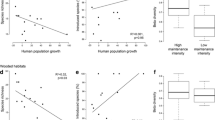Abstract
Data for the United Kingdom (UK) Manchester Butterfly Atlas produced conflicting species loss rates for increased urban development. In particular, a very low rate of loss was recorded (0.19 species for every 10% increase in urban cover) for the Mersey Valley mapped at a high resolution of 1 ha units. It was suggested that sampling artefacts (uneven recording) or failure to distinguish vagrant individuals from breeding populations cause this. Herein, results are reported for 30 sample squares, within the Mersey Valley, surveyed uniformly throughout 1999. It is shown that loss rates are as high as areas mapped at lower resolution over wider areas (0.67–0.68 species for every 10% increase in urban cover) and that increasingly stringent definitions of urban cover result in higher loss rates. Comparison with the data from the Atlas, but for the same 30 sample squares, indicate that the low rates at a fine scale for the complete Atlas data are more likely to be caused by uneven recording than from failure to record species status. However, progressive sampling of squares, despite uniform recording, will inevitably cause a reduction in loss rates of total species for increases in urban development.
Similar content being viewed by others
References
Dennis RLH (ed) (1992) The ecology of butterflies in Britain. Oxford University Press, Oxford
Dennis RLH (2001) Progressive bias in species status is symptomatic of fine-grained mapping units subject to repeated sampling. Biodiversity and Conservation 10: 483-494
Dennis RLH andBardell P (1996) The impact of extreme weather on Great Orme populations of Hipparchia semele (Linnaeus 1758) and Plebejus argus (Linnaeus 1758) (Papilionoidea: Satyrinae and Lycaenidae): hindsight, inference and lost opportunities. Entomologist's Gazette 47: 211-225
Dennis RLH andHardy PB (1999) Targeting squares for survey: predicting species richness and incidence for a butterfly atlas. Global Ecology and Biogeography Letters 8: 443-454
Dennis RLH andShreeve TG (1996) Butterflies on British and Irish Offshore Islands: Ecology and Biogeography. Gem Publishing Company, Wallingford, UK
Dennis RLH,Sparks TH andHardy PB (1999) Bias in butterfly distribution maps: the effects of sampling effort. Journal of Insect Conservation 3: 33-42
Dennis RLH andThomas CD (2000) Bias in butterfly distribution maps: the influence of hot spots and recorder's home range. Journal of Insect Conservation 4: 73-77
Emmet AM andHeath J (1990) The Butterflies of Great Britain and Ireland. Harley Books, Colchester, Essex, UK
Hardy PB (1998) Butterflies of Greater Manchester. PGL Enterprises, Sale, Cheshire, UK
Hardy PB andDennis RLH (1999) The impact of urban development on butterflies within a city region. Biodiversity and Conservation 8: 1261-1279
Shreeve TG (1995) Butterfly mobility. In: Pullin AS (ed) Ecology and Conservation of Butterflies, pp 37-45. Chapman & Hall, London
Author information
Authors and Affiliations
Rights and permissions
About this article
Cite this article
Dennis, R.L., Hardy, P.B. Loss rates of butterfly species with urban development. A test of atlas data and sampling artefacts at a fine scale. Biodiversity and Conservation 10, 1831–1837 (2001). https://doi.org/10.1023/A:1013161522916
Issue Date:
DOI: https://doi.org/10.1023/A:1013161522916




